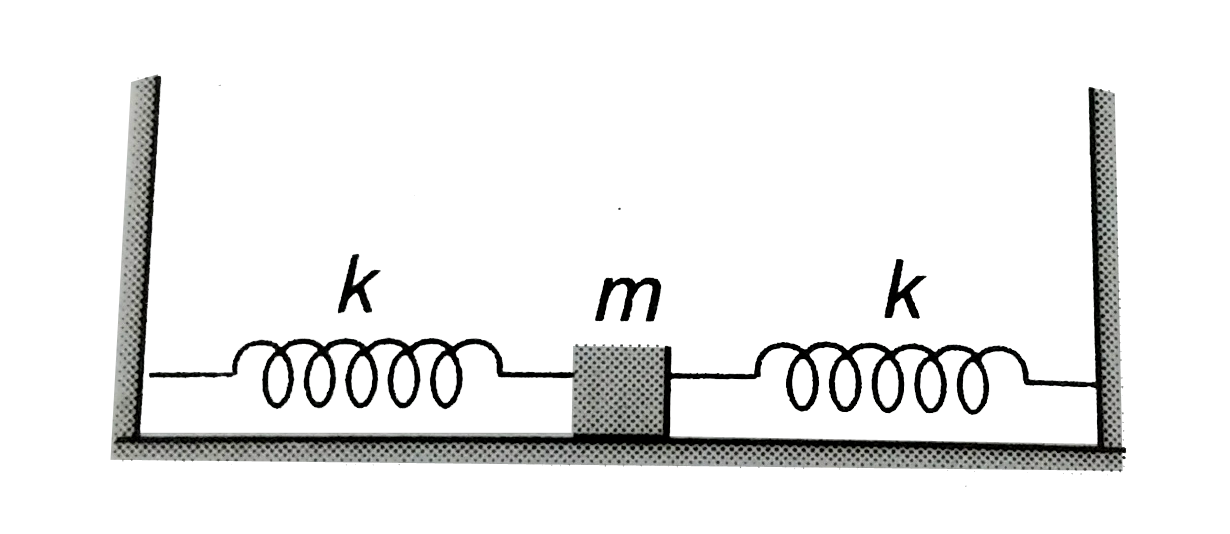When a particle of mass m is attached to a vertical spring of spring constant k and released, its motion is described by y(t)=y0sin2ωt, where 'y' is measured from the lower end of unstretched spring. Then ω is :
12√gy0
√gy0
√g2y0
√2gy0
To solve the problem step by step, we will analyze the motion of the mass attached to the spring and derive the value of ω.
Step 1: Understand the motion equation
The motion of the particle is described by the equation:
y(t)=y0sin2(ωt)
where y is the displacement from the lower end of the unstretched spring.
Step 2: Rewrite the sine squared term
Using the trigonometric identity:
sin2(θ)=1−cos(2θ)2
we can rewrite the equation as:
y(t)=y0⋅1−cos(2ωt)2
This simplifies to:
y(t)=y02−y02cos(2ωt)
Step 3: Identify the parameters
In the context of a mass-spring system, the angular frequency ω is related to the spring constant k and the mass m by the formula:
ω=√km
Step 4: Determine the equilibrium position
When the mass m is attached to the spring and released, it will stretch the spring to a new equilibrium position where the gravitational force equals the spring force:
mg=kx
where x is the displacement from the unstretched position.
Step 5: Relate the maximum amplitude to the spring constant
At maximum amplitude, the total displacement from the equilibrium position can be expressed as:
ymax=y0
From the equilibrium condition, we can express the spring constant in terms of the maximum amplitude:
k=mgy0
Step 6: Substitute k into the frequency equation
Substituting k into the equation for ω:
ω=√km=√mgmy0=√gy0
Step 7: Final expression for ω
Thus, we arrive at the final expression for ω:
ω=√g2y0
Conclusion
The value of ω is:
ω=√g2y0
The motion of the particle is described by the equation:
y(t)=y0sin2(ωt)
where y is the displacement from the lower end of the unstretched spring.
Using the trigonometric identity:
sin2(θ)=1−cos(2θ)2
we can rewrite the equation as:
y(t)=y0⋅1−cos(2ωt)2
This simplifies to:
y(t)=y02−y02cos(2ωt)
In the context of a mass-spring system, the angular frequency ω is related to the spring constant k and the mass m by the formula:
ω=√km
When the mass m is attached to the spring and released, it will stretch the spring to a new equilibrium position where the gravitational force equals the spring force:
mg=kx
where x is the displacement from the unstretched position.
At maximum amplitude, the total displacement from the equilibrium position can be expressed as:
ymax=y0
From the equilibrium condition, we can express the spring constant in terms of the maximum amplitude:
k=mgy0
Substituting k into the equation for ω:
ω=√km=√mgmy0=√gy0
Thus, we arrive at the final expression for ω:
ω=√g2y0
The value of ω is:
ω=√g2y0
Topper's Solved these Questions
Similar Questions
A ball of mass m is attached to the lower end of a light vertical spring of force constant K. The upper end of the spring is fixed. The ball is released from rest with the spring at its normal ( unstretched ) length, and comed to rest again after descending through a distance x.
View SolutionIn an ideal pulley particle system, mass m2 is connected with a vertical spring of stiffness k. If mass m2 is released from rest, when the spring is underformed, find the maximum compression of the spring.

View Solution
Knowledge Check
A particle of mass m is hanging vertically by an ideal spring of force constant K . If the mass is made to oscillate vertically, its total energy is
Amaximum at the extreme positionBmaximum at the mean positionCminimum at the mean positionDsame at all positions.A particle of mass (m) is attached to a spring (of spring constant k) and has a natural angular frequency ω0. An external force R(t) proportional to cosωt(ω≠ω0) is applied to the oscillator. The time displacement of the oscillator will be proportional to.
Amω20−ω2B1m(ω20−ω2)C1m(ω20+ω2)Dmω20+ω2
A particle of mass m is fixed to one end of a massless spring of spring constant k and natural length l0. The system is rotated about the other end of the spring with an angular velocity ω ub gravity-free space. The final length of spring is
View SolutionA block of mass m hangs from a vertical spring of spring constant k. If it is displaced from its equilibrium position, find the time period of oscillations.
View Solutiona block of mass 0.1 kg attached to a spring of spring constant400Nm pulled horizontally from x=0 tox1=10mm. Find the work done by the spring force
View SolutionA particle of mass (m) is attached to a spring (of spring constant k) and has a natural angular frequency ω0. An external force F(t) proportional to cosωt (ω≠ω0) is applied to the oscillator. The time displacement of the oscillator will be proportional to.
View SolutionTwo equal masses are attached to the two ends of a spring of spring constant k. The masses are pulled out symmetrically to stretch the spring by a length x over its natural length. The work done by the spring one each mass is
View Solution
A block of mass m is attached to two unstretched springs of spring constant k, each as shown. The block is displaced towards right through a distance x and is released The speed of the block as it passes through the mean position will be
View Solution
